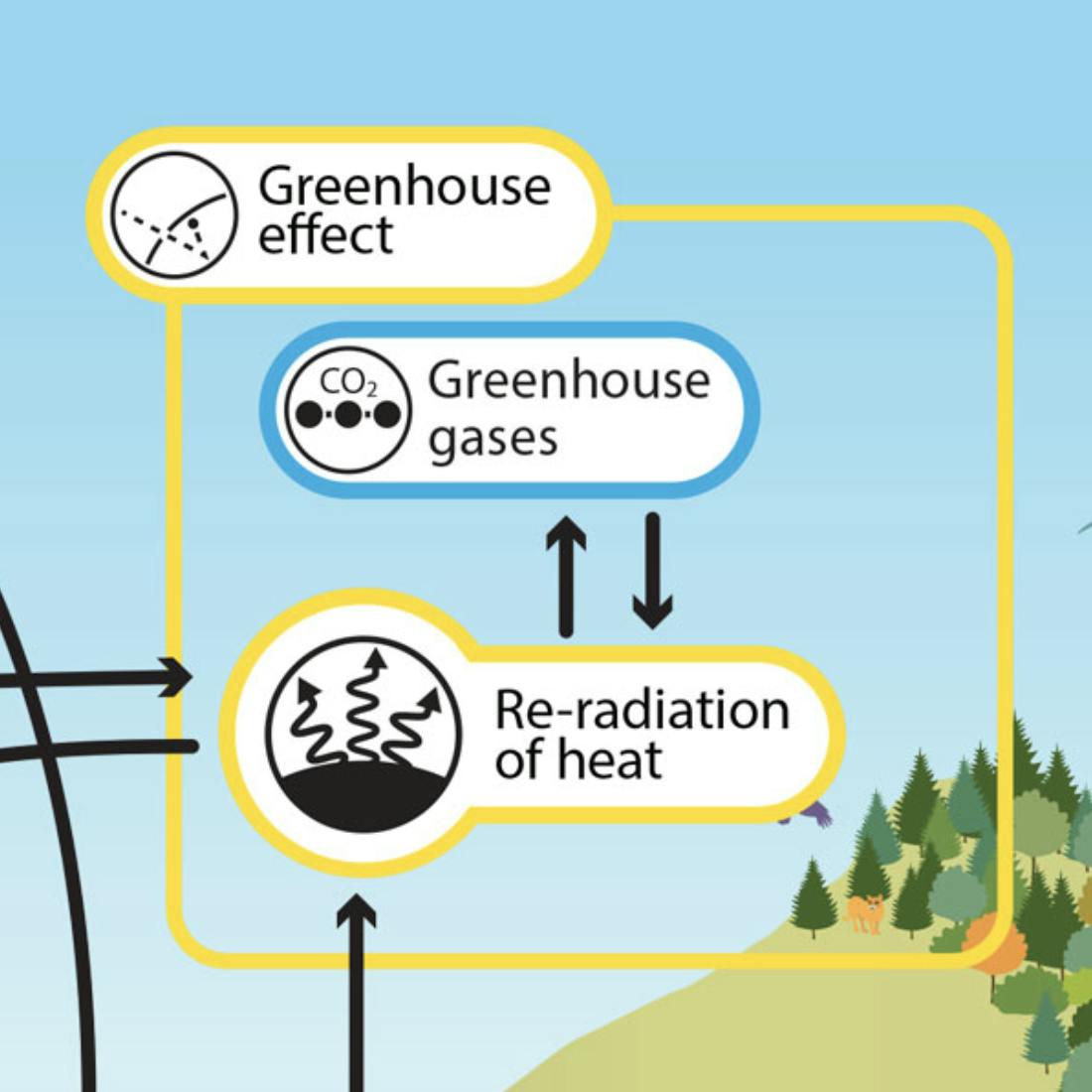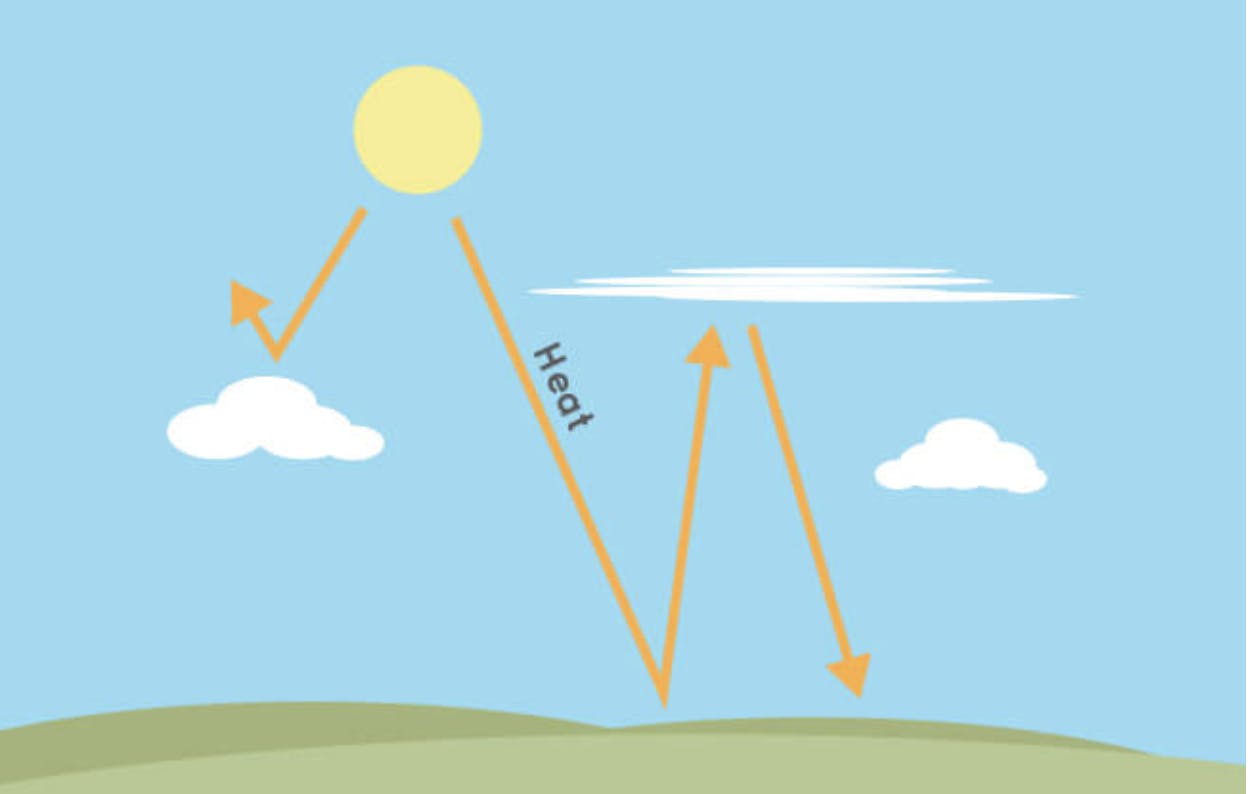TL;DR Science: The Greenhouse Effect
By Angelo Chen
February 09, 2022 · 4 minute read
Biology
Earth Science
Environmental Science
You have likely heard of the greenhouse effect before, but do you know what it actually is? In this week’s article, we go into what the greenhouse effect is, how it works, and what factors contribute to it. This is part 1 in a 3-part series about the greenhouse effect and greenhouse gases! After reading, check out those articles too!
What It Is
The greenhouse effect is the trapping of the sun’s heat in a planet’s lower atmosphere, causing the overall heating of the planet. This occurs because of differing interactions between the atmosphere and various wavelengths of light. If you don’t have a basic understanding of the electromagnetic spectrum, we recommend reading up about it in our article about light here!
How It Works
The Sun’s light energy is transmitted as roughly 53% infrared, 43% visible light, and 4% ultraviolet. These waves differ in their interaction with our atmosphere because of their wavelengths. Greenhouse gases like carbon dioxide (CO2) absorb infrared radiation, but nothing with shorter wavelengths, becoming energized and radiating heat back towards earth.

The visible light and UV radiation reaches the earth’s surface and energizes the molecules it hits. This energy is then released back into the air as heat, or thermal energy—infrared radiation. The reason for this is because of something known as Wien’s displacement law, but basically, since the Earth’s surface is cooler than the Sun, energy radiates back out at wavelengths much longer than the ones that were absorbed.
As we know, this type of radiation can be more easily absorbed by greenhouse gases, which then radiate the heat back into Earth. As a result, more energy is being trapped in the Earth’s atmosphere than is being released back into space, causing the overall temperature of our planet to rise.
Clouds
While greenhouse gases are generally the prime suspect for causing the greenhouse effect, there are several other factors that come into play as well. One of these factors involves clouds, but they are much more than simply blankets over the Earth. Like greenhouse gases, however, their influence on the global climate also has to do with infrared radiation absorption, and reflection of sunlight.

Clouds have several effects regarding the Earth’s greenhouse effect, depending on their type. Lower clouds, like cumulus clouds, generally reflect more heat than they trap, thus helping to cool the Earth. On the other hand, higher clouds, like cirrus clouds, generally trap more heat than they trap, and contribute to heating the Earth. Additionally, the effect of clouds on the Earth can vary depending on their density, location, or even the time of day. Most scientists believe that clouds have a generally cooling effect on the Earth, but because of their volatile nature, it is still disputed whether they are beneficial or harmful overall.
What we do know about clouds is that they are thinning over time because the Earth is cooling. One direct result of this is that fewer cumulus clouds will blanket the Earth, leading to potentially further warming. This illustrates the cyclic nature that global warming can have: higher temperatures can lead to effects such as cloud thinning, which contributes back towards global warming.

A Potential Solution
One possible solution to clouds warming the Earth is cirrus cloud thinning. As previously mentioned, cirrus clouds differ from other clouds in that they often absorb more infrared radiation than they do reflect sunlight. Therefore, a proposed solution to help stop climate change is to thin cirrus clouds. This would overall decrease the amount of heat being trapped in the Earth, as cirrus clouds are a net negative for our climate.
This would be done by taking advantage of how clouds form. A fun fact about clouds is that the raindrops they form are actually mathematically impossible to be formed on their own. They require a nucleation site, where water molecules can attach to. Often, this is a particle of dust, soot, or salt. The water vapor molecules condense around these nucleation sites to form clouds and raindrops. For more information about why and how this works, check out these videos from minutephysics and MinuteEarth!
Why Raindrops Are Mathematically Impossible

Unlike what you may know about clouds being just masses of water vapor, cirrus clouds and other high-altitude clouds are actually made of ice. This ice, like raindrops, requires a nucleation site. With many small nucleation sites, cirrus clouds generally form by homogeneous freezing, or the freezing of many, very small ice crystals. This creates a more dense, uniform cloud.
In contrast, cirrus cloud thinning would inject aerosols into the air, causing fewer, larger ice crystals to form. This results in a thinner, less dense cloud, which would diminish the negative effects of cirrus clouds. Fewer, thinner cirrus clouds would lead to more infrared radiation being released, and a cooler Earth.
TL;DR:
The greenhouse effect is a phenomenon that results in the trapping of heat inside the Earth’s atmosphere, leading to increased global temperatures and the effects of climate change we are experiencing today. This is due to interactions involving wavelengths of types of light emitted by the Sun. Many things like greenhouse gases and some clouds trap heat (infrared radiation) and cause the overall heating of the Earth.
Make sure to check out part 2 of this greenhouse effect/gases series coming soon!
Sources
https://en.wikipedia.org/wiki/Greenhouse_effect
https://en.wikipedia.org/wiki/Sunlight
https://climate.mit.edu/ask-mit/how-do-greenhouse-gases-trap-heat-atmosphere
https://scied.ucar.edu/learning-zone/how-climate-works/greenhouse-effect
https://en.wikipedia.org/wiki/Wien%27s_displacement_law
https://ugc.berkeley.edu/background-content/re-radiation-of-heat/
https://e360.yale.edu/features/why-clouds-are-the-key-to-new-troubling-projections-on-warming
https://science.nasa.gov/science-news/science-at-nasa/2002/22apr_ceres/
https://climatekids.nasa.gov/cloud-climate/
https://skepticalscience.com/print.php?r=323
https://earthobservatory.nasa.gov/features/Clouds
https://en.wikipedia.org/wiki/Solar_geoengineering
https://en.wikipedia.org/wiki/Cirrus_cloud_thinning
https://www.metoffice.gov.uk/weather/learn-about/weather/types-of-weather/clouds/high-clouds/cirrus
Image Sources
https://climatekids.nasa.gov/greenhouse-effect/
https://ugc.berkeley.edu/background-content/re-radiation-of-heat/
https://climatekids.nasa.gov/cloud-climate/
https://www.metoffice.gov.uk/weather/learn-about/weather/types-of-weather/clouds/high-clouds/cirrus
Did you enjoy this article?
About The Author
Angelo is currently a junior at Suncoast Community High School. He enjoys spending time with his dog, and playing volleyball and violin as hobbies. He also enjoys doing math, in and out of school. If you have any questions about this article, feel free to contact him at angelo@sciteens.org.